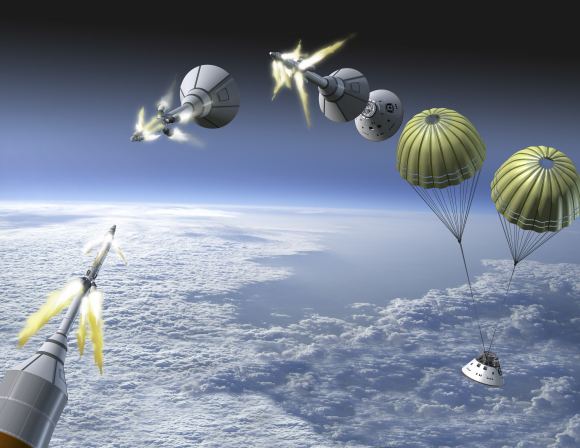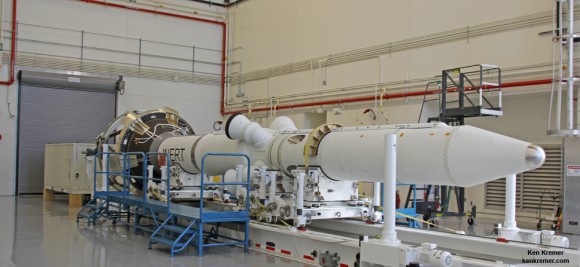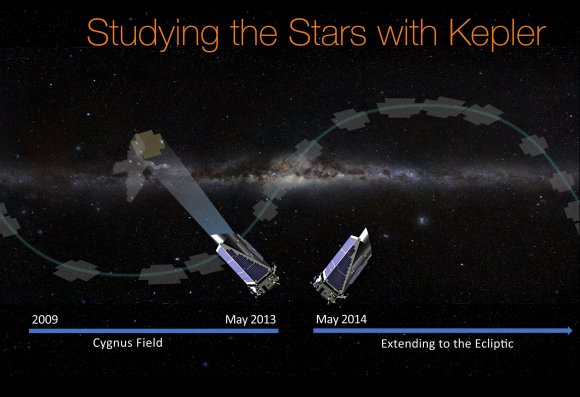Testing is one of the unsung steps in the engineering process. Talk to any product development engineer, and they will tell you how big of a milestone passing “V&V” – or verification and validation – testing is. Testing is even more critical when you work on equipment meant for the harsh space environment. It is also more challenging to mimic those harsh environments on Earth. Luckily for some of NASA’s more critical upcoming missions, another government agency has a unique test lab to help V&V with some of its most critical components – their heat shields.
Continue reading “Testing Heat Shields for Different Atmospheres”NASA has Simulated a Tiny Part of the Moon Here on Earth

Before going to the Moon, the Apollo astronauts trained at various sites on Earth that best approximated the lunar surface, such as the volcanic regions Iceland and Hawaii and deserts in the US Southwest. To help prepare for upcoming robotic and human Artemis missions, a newly upgraded “mini-Moon” lunar testbed will allow astronauts and robots to test out realistic conditions on the Moon including rough terrain and unusual sunlight.
Continue reading “NASA has Simulated a Tiny Part of the Moon Here on Earth”NASA Simulates Their Orion Abort System. Now That Would be a Crazy Ride

When it comes time for NASA to send astronauts back to the Moon and on to Mars, a number of new spacecraft systems will come into play. These include the Space Launch System (SLS), the most powerful rocket ever built, and the Orion Multi-Purpose Crew Vehicle (MPCV) – a next-generation spacecraft that will carry crews beyond Low Earth Orbit (LEO).
Naturally, before either of these systems can conduct missions, extensive testing needs to be conducted to ensure they are safe and will perform well. In this spirit, NASA Advanced Supercomputing (NAS) research scientists are currently conducting highly-detailed simulations and visualizations to ensure that the Orion spacecraft’s Launch Abort Vehicle (LAV) will keep crews safe, should an emergency occur during takeoff.
Basically, the LAV is the combined configuration of the Orion Launch Abort System (LAS) and crew module, and is designed to get the crew to safety if an emergency occurs on the launch pad or during the first two minutes of flight. These simulation and visualization techniques, which were conducted with the Pleiades supercomputer at the NASA Ames Research Center, predict how vibrations will affect the Orion spacecraft’s launch abort vehicle during takeoff.

Not only are these tests assisting with the design efforts of the Orion LAV motor (a collaborative effort between NASA and Orion prime contractor Lockheed Martin), they are also rather unprecedented as far as spacecraft development goes. As Francois Cadieux, a research scientist in the NAS Computational Aerosciences Branch, explained:
“This is one of the first times where large eddy simulation (LES) techniques have been used in full-scale spacecraft analysis and design at NASA. I’m excited to play a part in the agency’s next big human space exploration project—this work brings LES to a point where it can provide accurate predictions within a short enough turnaround time to guide Orion’s design.”
Previously, the use of such high-fidelity tools has been largely restricted to academic research, and not something private industry contractors could take advantage of. Together with Michael Barad – an aerospace engineer at the Ames Research Center – Cadieux produced a variety of turbulence-resolving computational fluid dynamics (CFD) simulations using the NAS-developed Launch Ascent and Vehicle Aerodynamics (LAVA) software.
They were assisted by NAS visualization experts, who helped the researchers identify different types of vortices that can caused noise and vibrations. Using this simulation data, the visualization experts created a series of high-quality images and movies that illustrated what kind of flow dynamics the Orion LAS would experience during a launch abort. As Cadieux explained:
“From these visualizations, we were able to identify areas of high vibrational loads on the vehicle, and their sources. What we learned is that noise coming from the turbulence of the plume is substantially higher than any noise generated from its interaction with attached shockwaves.”

The video below shows the simulation of an ascent abort scenario, where the LAS has detached from the SLS and is traveling at close to the speed of sound. The abort process initiates with the ignition of the LAS motor and then slows down as the pressure and airflow conditions become particularly harsh.
The colored plumes indicate high pressure (red) and low pressure (blue), with pixels changing from blue to red (and vice versa) in relation to pressure waves that cause vibrations on the vehicle (white). The regions where the color changes abruptly, but remains generally blue or red over time, indicates the presence of shock waves. In the end, these simulations are directly impacting the spacecraft’s design and will help ensure astronaut safety and spacecraft performance.
“We’re still asking lots of questions,” said Cadieux. “Like, how do the loads on the LAV surface change at higher angles of attack? How do we best use data from wind tunnel tests to predict loads for actual flight conditions where the vehicle is accelerating?”
The answers to these questions will will be used to design the next series of ground tests, crew mockup tests, and critical flight tests, which will will prepare the Orion spacecraft for its first crewed mission – Exploration Mission 2 (EM-2). This mission, which is scheduled for launch by 2023, will consist of four crew members conducting a lunar flyby and delivering the first components for the Deep Space Gateway.
Be sure to check out the simulation video as well, courtesy of the NASA Ames Research Center:
NASA Announces 10, That’s Right 10! New Planets in Their Star’s Habitable Zone

The Kepler space telescope is surely the gift that keeps on giving. After being deployed in 2009, it went on to detect a total of 2,335 confirmed exoplanets and 582 multi-planet systems. Even after two of its reaction wheels failed, it carried on with its K2 mission, which has discovered an additional 520 candidates, 148 of which have been confirmed. And with yet another extension, which will last beyond 2018, it shows no signs of stopping!
In the most recent catalog to be released by the Kepler mission, an additional 219 new planet candidates have been added to its database. More significantly, 10 of these planets were found to be terrestrial (i.e. rocky), of comparable in size to Earth and orbited within their star’s habitable zone – the distance where surface temperatures would be warm enough to support liquid water.
These findings were presented at a news conference on Monday, June 19th, at NASA’s Ames Research Center. Of all the catalogs of Kepler candidates that have been released to date, this one is the most comprehensive and detailed. The eighth in a series of Kepler exoplanet catalogs, this one is based on data that was obtained from the first four years of the mission and is the final catalog that covers the spacecraft’s observations of the Cygnus constellation.
Since 2014, Kepler has ceased looking at a set starfield in the Cygnus constellation and has been collecting data on its second mission – observing fields on the plane of the ecliptic of the Milky Way Galaxy. With the release of this catalog, there are now 4,034 planet candidates that have been identified by Kepler – of which 2,335 have been verified.
An important aspect of this catalog were the methods that were used for producing it, which were the most sophisticated to date. As with all planets detected by Kepler, the latest finds were all made using the transit method. This consists of monitoring stars for occasional dips in brightness, which is used to confirm the presence of planets transiting between the star and the observer.
To ensure that the detections in this latest catalog were real, the team relied on two approaches to eliminate false positives. This consisted of introducing simulated transits into the dataset to make sure the dips that Kepler detected were consistent with planets. Then, they added false signals to see how often the analysis mistook these for planet transits. From this, they were able to tell which planets were overcounted and which were undercounted.
This led to another exciting find, which was the indication that for all of the smaller exoplanets discovered by Kepler, most fell within one of two distinct groupings. Essentially, half the planets that we know of in the galaxy are either rocky in nature and larger than Earth (i.e. Super-Earth’s), or are gas giants that are comparable in size to Neptune (i.e. smaller gas giants).
This conclusion was reached by a team of researchers who used the W.M. Keck Observatory to measure the sizes of 1,300 stars in the Kepler field of view. From this, they were able to determine the radii of 2,000 Kepler planets with extreme precision, and found that there was a clear division between rocky, Earth-sized planets and gaseous planets smaller than Neptune – with few in between.
As Benjamin Fulton, a doctoral candidate at the University of Hawaii in Manoa and the lead author of this study, explained:
“We like to think of this study as classifying planets in the same way that biologists identify new species of animals. Finding two distinct groups of exoplanets is like discovering mammals and lizards make up distinct branches of a family tree.”
These results are sure to have drastic implications when it comes to knowing the frequency of different types of planets in our galaxy, as well as the study of planet formation. For instance, they noted that most rocky planets discovered by Kepler are up to 75% larger than Earth. And for reasons that are not yet clear, about half of them take on hydrogen and helium, which swells their size to the point that they become almost Neptune-sized.

These findings could similarly have significant implications in the search for habitable planets and extra-terrestrial life. As Mario Perez, Kepler program scientist in the Astrophysics Division of NASA’s Science Mission Directorate, said during the presentation:
“The Kepler data set is unique, as it is the only one containing a population of these near Earth-analogs – planets with roughly the same size and orbit as Earth. Understanding their frequency in the galaxy will help inform the design of future NASA missions to directly image another Earth.”
From this information, scientists will be able to know with a greater degree of certainty just how many “Earth-like” planets exist within our galaxy. The most recent estimates place the number of planets in the Milky Way at about 100 billion. And based on this data, it would seem that many of these are similar in composition to Earth, albeit larger.
Combined with a statistical models of how many of these can be found within a circumstellar habitable zone, we should have a better idea of just how many potentially-life-bearing worlds are out there. If nothing else, this should simplify some of the math in the Drake Equation!
In the meantime, the Kepler space telescope will continue to make observations of nearby star systems in order to learn more about their exoplanets. This includes the TRAPPIST-1 system and its seven Earth-sized, rocky planets. Its a safe bet that before it is finally retired after 2018, it will have some more surprises in store for us!
Further Reading: NASA, NASA Kepler and K2


